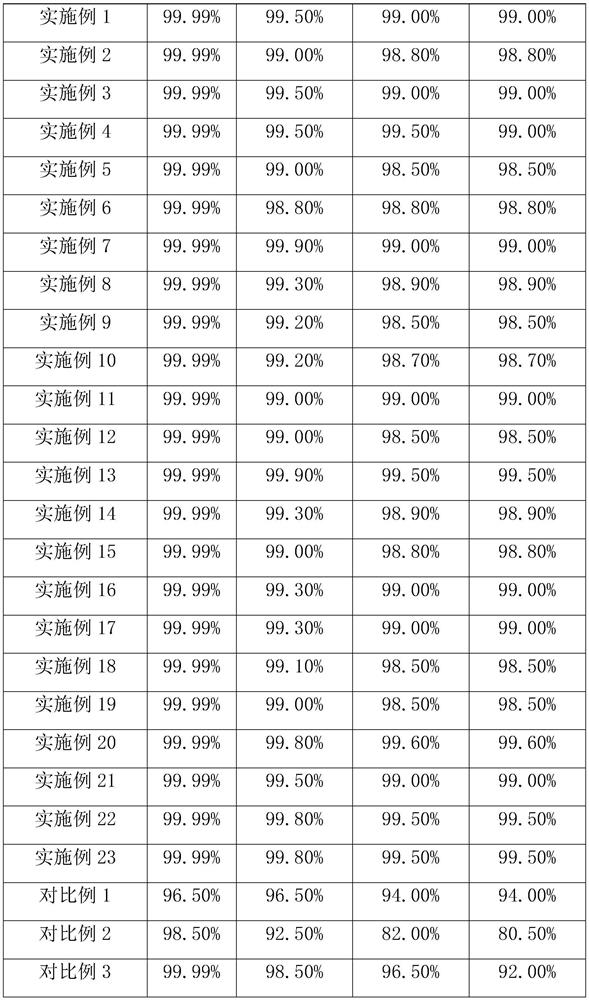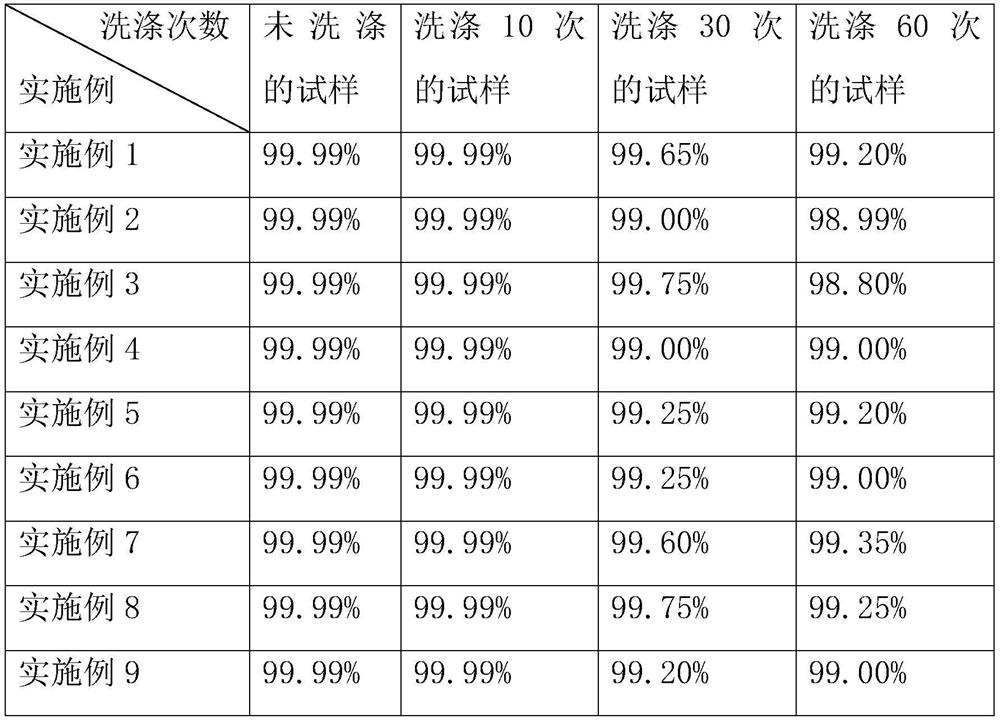Preparation method for antibacterial cloth and antibacterial cloth
A technology for fabrics and raw materials, applied in textile, biochemical fiber treatment, yarn and other directions, can solve the problems of easy shedding and poor durability, and achieve the effect of good antibacterial effect, good antibacterial durability, and delaying the disappearance of antibacterial properties.
- Summary
- Abstract
- Description
- Claims
- Application Information
AI Technical Summary
Problems solved by technology
Method used
Image
Examples
preparation example 1
[0052] 1. Pretreatment: Put 30kg of bagasse viscose fiber, 10kg of coconut charcoal fiber, and 30kg of polyester fiber into a water bath for water bath heat treatment. The temperature of the water bath in the water bath is 75°C, and the water bath time is 2 hours;
[0053] Place the fiber treated in the water bath in a drying room, and dry at 120°C until the fiber humidity is 18%;
[0054] Soak the dried fibers in the mixture of antistatic agent and anti-fluffing agent for 1 hour. The antistatic agent can be non-ionic antistatic agent LD-940H, and the anti-fluffing agent can be G-KQ, LD-940H and G- The volume ratio of KQ is 1:2.5;
[0055] Place the soaked fibers in a drying room and dry at 120°C for 3 hours;
[0056] 2. The dried bagasse viscose fiber and polyester fiber are spirally intertwisted to obtain a blended yarn;
[0057] 3. The blended yarn and the dried coconut charcoal fiber are spirally twisted according to the corresponding parts by weight to obtain the bagass...
preparation example 2
[0059] 1. Pretreatment: Put 35kg of bagasse viscose fiber, 15kg of coconut charcoal fiber, and 35kg of polyester fiber into a water bath for water bath heat treatment. The temperature of the water bath in the water bath is 75°C, and the water bath time is 2 hours;
[0060] Place the fiber treated in the water bath in a drying room, and dry at 120°C until the fiber humidity is 18%;
[0061] Soak the dried fibers in the mixture of antistatic agent and anti-fluffing agent for 1 hour. The antistatic agent can be non-ionic antistatic agent LD-940H, and the anti-fluffing agent can be G-KQ, LD-940H and G- The volume ratio of KQ is 1:2.5;
[0062] Place the soaked fibers in a drying room and dry at 120°C for 3 hours;
[0063] 2. The dried bagasse viscose fiber and polyester fiber are spirally intertwisted to obtain a blended yarn;
[0064] 3. The blended yarn and the dried coconut charcoal fiber are spirally twisted according to the corresponding parts by weight to obtain the bagass...
preparation example 3
[0066] 1. Pretreatment: Put 40kg of bagasse viscose fiber, 20kg of coconut charcoal fiber, and 40kg of polyester fiber into a water bath for water bath heat treatment. The temperature of the water bath in the water bath is 75°C, and the water bath time is 2 hours;
[0067] Place the fiber treated in the water bath in a drying room, and dry at 120°C until the fiber humidity is 18%;
[0068] Soak the dried fibers in the mixture of antistatic agent and anti-fluffing agent for 1 hour. The antistatic agent can be non-ionic antistatic agent LD-940H, and the anti-fluffing agent can be G-KQ, LD-940H and G- The volume ratio of KQ is 1:2.5;
[0069] Place the soaked fibers in a drying room and dry at 120°C for 3 hours;
[0070] 2. The dried bagasse viscose fiber and polyester fiber are spirally intertwisted to obtain a blended yarn;
[0071] 3. The blended yarn and the dried coconut charcoal fiber are spirally twisted according to the corresponding parts by weight to obtain the bagass...
PUM
 Login to View More
Login to View More Abstract
Description
Claims
Application Information
 Login to View More
Login to View More - R&D
- Intellectual Property
- Life Sciences
- Materials
- Tech Scout
- Unparalleled Data Quality
- Higher Quality Content
- 60% Fewer Hallucinations
Browse by: Latest US Patents, China's latest patents, Technical Efficacy Thesaurus, Application Domain, Technology Topic, Popular Technical Reports.
© 2025 PatSnap. All rights reserved.Legal|Privacy policy|Modern Slavery Act Transparency Statement|Sitemap|About US| Contact US: help@patsnap.com



